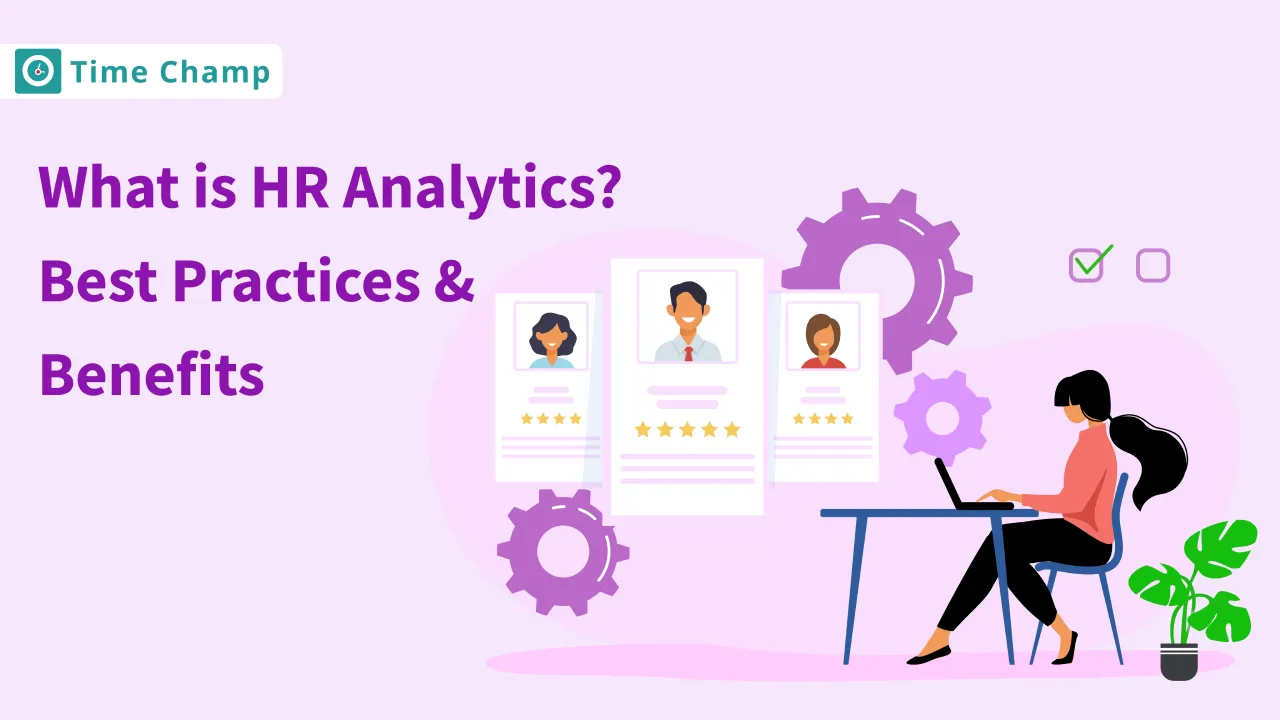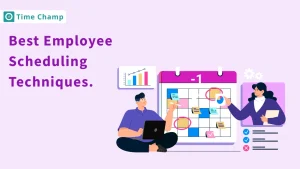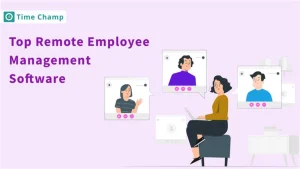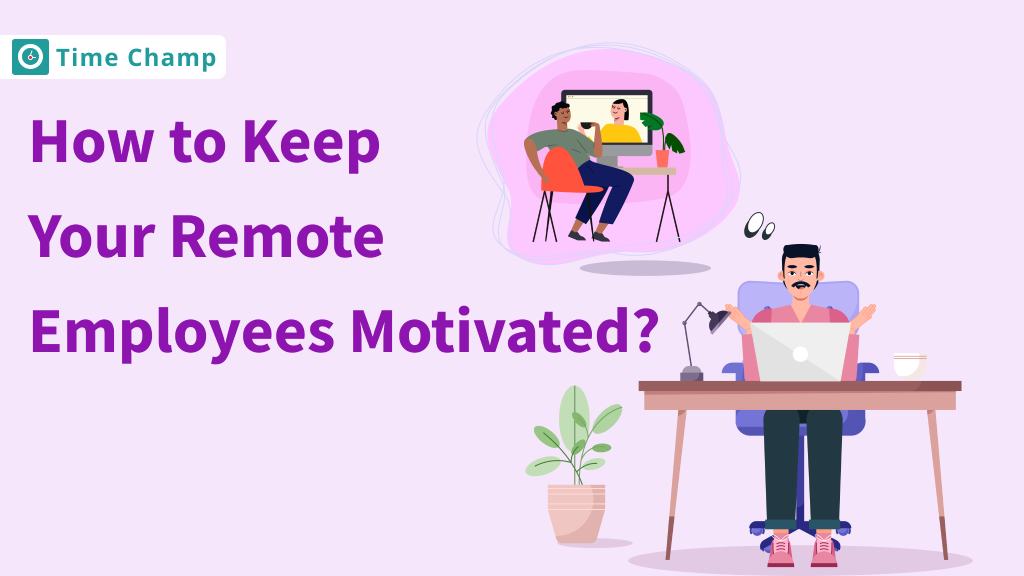What is HR Analytics?
Think of HR analytics as a way to use numbers and data to understand how people work in a company, kind of like using a map to navigate through a city.
HR analytics is a method used to understand and improve employee performance. Through employee satisfaction surveys, focus groups, and exit interviews organizations can find out how satisfied their employees are, how hard they work and the reasons why some of them leave. Through this process, businesses can make correct choices such as hiring, training and employee satisfaction. It’s all about implementing information to improve work for everyone involved.
What is the Importance of HR Analytics?
HR data analytics enables organizations to make smarter workforce decisions by analyzing data on performance, engagement, turnover, and other HR metrics. This helps identify what drives success and informs strategies for recruitment, training, and performance management, leading to improved productivity, retention, and overall organizational performance.
HR analytics also helps companies identify workforce trends early and gives them an edge in talent management.
What is the Use of HR Analytics?
There are many uses of HR analytics in an organization come let’s discuss some of them.
- Human resource analytics relies on data to make decisions regarding human resources management.
- It helps organizations to know employee behaviour, performance, and engagement.
- Through the analysis of data, organizations can improve processes and strategies.
- Workforce analytics enhances recruitment, training, performance management, and retention.
- It enables organizations to find out the areas that need improvement and implement targeted interventions.
- Generally, Human resource analytics contributes to better decisions in the workforce, which, in turn, improves productivity, efficiency, and employee satisfaction.
Benefits of using HR Analytics
Here are some of the benefits of incorporating HR analytics into your business.
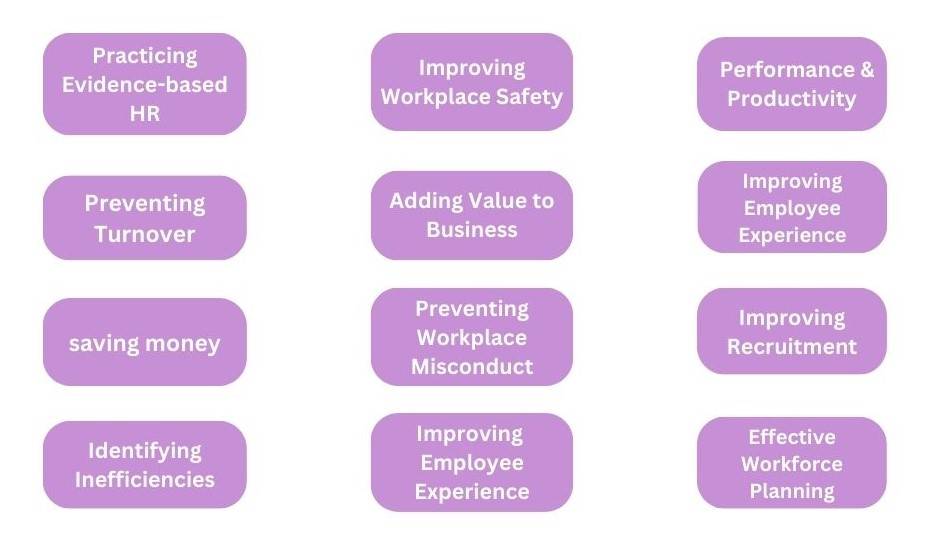
Using Data Analytics in HR
HR analytics is similar to employing a magnifying glass to look at people in the office more closely. The HR professionals look at the data instead of just relying on gut feelings or guesses and they use it to make smart decisions related to managing employees. This is about getting, studying and understanding information to enable a company to have the best working conditions.
Picture yourself as a company owner and you want to find out if your workers are happy and productive. staff analytics helps you to achieve that precisely. Here is how.
- Collecting Data: The HR department can collect all sorts of information about employees, such as how many hours they work, their performance reviews, and even how they feel about their jobs.
- Analyzing Data: After collecting all this data, it is time to look for patterns or trends. Say, you become aware that those employees who have regular meetings with their managers remain at the company longer.
- Making Decisions: With such knowledge, HR can make more informed decisions. Possibly, you will arrange more frequent meetings with managers to be able to raise the level of employee satisfaction and retention.
- Predicting the Future: Employee data analytics can also be used to predict the future. Through the examination of historical data, you can forecast events such as which section may need more employees or which employees may be at risk of quitting.
- Improving Processes: Lastly, people analytics contributes to enhancing processes. Through the process of continual data monitoring and analysis, HR can identify the spots where things aren’t functioning properly and take steps to improve them.
HR analytics, in simple words, is the crystal ball of the managerial role in the field of employee management. It facilitates organizations to determine their workforce properly, be wise in their decisions, and create a happier and more productive workplace.
How Do I Choose the Right Software for My Business?
Choosing the correct software that matches your business needs from an ocean of options available in the market can be tricky, but no worries we are here to help you out.
You just need to keep the following points in mind while choosing HR analytics software for your business.
1. Identify Your Needs
- Make a clear list of the tasks or processes the software needs to take care of.
- Identify key features and functions that are required to meet your business requirements.
2. Consider Scalability
- Look for software that is capable of growing along with your business
- Make sure it can handle over workload or accommodate a larger user base as your business grows.
3. Evaluate User-Friendliness
- Adopt simple and user-friendly software.
- Think about the learning curve of your team and do not choose the software which requires complex training.
4. Assess Compatibility
- Check if the software is compatible with the systems and tools you already have.
- With seamless integration, workflows can get automated and data silos can be eliminated.
5. Compare Pricing Models
- Evaluate pricing policies, like one-time purchase, subscription-based, or pay-per-user.
- Select the pricing model that suits your budget or the one that offers you the most value for money.
6. Review Customer Support
- Look for software that offers reliable customer support.
- Evaluate their speed, readiness and the quality of support they provide.
7. Reading Reviews and Get Recommendations
- Get the necessary details by reading user reviews and asking your friends for their recommendations.
- Take into account both negative and positive feedback to make a well-informed choice.
8. Trial the Software
- Make use of free trials such as demos provided by software vendors.
- Try the software to see whether it works and is easy to use with your team.
9. Consider Customization Options
- Check whether the software provides customization options to tailor it to your unique requirements.
- Personalized features may boost the flexibility and adaptability of a tool.
10. Think Long-Term
- Look for software that is consistent and aligns with your long-term business vision.
- Think about aspects of the system such as support for maintenance and updates, as well as scalability in order to ensure long-term suitability.
Redefine Your Workforce and Drive HR Excellence
With Time Champ's inclusive HR analytics
Signup for FreeBook DemoHow To Use HR Analytics: Best Practices
Using HR analytics to increase workspace efficiency is like the use of a map to get the fastest way to your destination. It is about listening to data and understanding how your employees work and finding ways to help them do their jobs more rapidly. Let’s discuss how you can use them you boost your workplace productivity.
- Identify Productivity Metrics: First of all, figure out what productivity is for your organization. It could include metrics, for example, employee output, project completion rates, or time spent on tasks. By specifying what productivity is, it will be easier for you to evaluate and monitor your progress accurately.
- Collect Relevant Data: Collect data on different aspects of employee performance and how they work. This could be anything from time-tracking software to task completion rates to a manager or colleague feedback. The point here is to gather data that reveals how employees utilize their time and where the improvements should be made.
- Analyzing Work Patterns: Run HR analytics tools on the data to look for patterns or trends in employee actions. Consider items that may be contributing to productivity, for instance, the work distribution, communication barriers, and workflow bottlenecks.
- Identify Areas for Improvement: Employing your findings, indicate the exact points where productivity can be enhanced. This may be achieved by simplifying the procedures, shifting the allocation of resources or offering further training and assistance to the employees.
- Implement Solutions: After you have identified some areas to be improved, take the time to work on them. This can be done by acquiring new tools or technologies to automate repetitive tasks, reorganizing teams to suit skills and tasks better, and providing training to help employees work faster.
- Monitor Progress: Constantly evaluate the effect of your actions on productivity indexes. Monitor KPIs regularly to verify whether the changes are bringing about the intended impact.
Examples of How Businesses Use HR Analytics
Here are some of the organizations that used HR analytics to supercharge their workforce and lead to a more productive workplace.
1. Amazon
Amazon‘s human resource analytics is meant to improve staff performance and employee retention. By doing data analysis on employee engagement, turnover and performance metrics, Amazon can easily identify areas of improvement and implement the targeted actions. For instance, they apply predictive analytics in identifying the employees at risk of leaving and take a proactive approach by addressing their issues, such as offering career development opportunities or adjusting their schedules.
2. Cisco Systems
Cisco Systems uses Human resource analytics to ensure that diversity and inclusion initiatives are effective. Cisco uses data analysis to examine employee demographics, hiring procedures, and promotion rates and then identifies those areas where diversity efforts can be improved. They leverage the information to create recruitment strategies that are tailored, diversity training, and mentorship programs to help those who are underrepresented within the organization.
3. Procter & Gamble (P&G)
Workforce analytics is a powerful tool used by P&G to help in workforce planning and talent management. Employee data analysis on the company’s skills, performance, and career goals helps P&G identify the gaps in the talent pipeline and develop strategies to overcome these gaps. They, instead, predict the future workforce requirements and employ the right talent to support the company’s growth and innovation.
4. Microsoft
Through employee analytics, Microsoft aims to enhance employee engagement and satisfaction. Through the help of data mining from employee surveys, feedback platforms, and performance evaluations, Microsoft identifies those which lead to employee happiness and well-being. They apply this knowledge to design initiatives such as flexible work arrangements, wellness programs and recognition schemes to enhance employee motivation and retention.
5. LinkedIn
LinkedIn uses human resource analytics to improve the quality of recruitment and the acquisition of suitable talent. By studying the patterns and trends in the data of candidate profiles, job postings and hiring outcomes, LinkedIn can help to identify the recruitment process. Such data is then used to refine the job advertisements, target passive candidates and enhance the candidate experience which further increases the chances of the platform to attract the best talents.
HR Metrics
1. Employee Turnover Rate
This indicator will show how many employees the organization has lost during a given period of time.

2. Retention Rate
The retention rate is the number of employees who stayed with the organization during a given period over the total number of staff at the beginning of that period.

3. Employee Engagement Score
This metric measures employee engagement and happiness in the organization at a certain level.

4. Cost per Hire
The cost per hire is an indicator of the total cost required to fill a job opening.

5. Absenteeism Rate
The absenteeism rate is the percentage of all scheduled hours that are not worked by employees because they are absent.

6. Time to Fill
It is the average time of the vacancy until the time it is filled in from the time it is opened to the moment the candidate accepts the offer.

Best Software for HR Analytics
Try Time Champ, it is a comprehensive HR analytics software that uses cutting-edge technologies to regularly keep up with technology advancements and helps HR to build a trustworthy and efficient workforce.
Features like Attendance
management take care of the
attendance records and leaves of the
employees. It is supported by
productivity analysis which helps to
define the potential for improvement
of the employees’
performance. Furthermore,
the progress of the project is
tracked to ensure that resources are
utilized effectively.
This software also creates
personalized reports and analyzes
workforce data to offer useful
information. In addition, it makes
it easier to manage the employees to
ensure that they are available in
the right numbers. Performance
management is used to measure the
performance of employees while task
management is used to assign
tasks, follow up and monitor the
progress of the staff.
FAQs
Human resource analytics is a process of applying data to get the type of information that is related to the different aspects of human resources management for example recruitment, performance, and engagement.
The role of staff analytics is to help organizations make data-driven decisions, improve workforce performance, increase employee satisfaction, and attain strategic business objectives.
Workforce analytics helps organizations find out what recruitment strategies work, who they should be targeting, how to shorten hiring procedures, and how to reduce the time-to-fill vacancy.
People analytics explore employee performance data to point out skill gaps, measure the effectiveness of training and order training according to organizational goals.
Human resources analytics monitors engagement by administering surveys and feedback channels identifies factors that make or break the engagement and develops plans to make the workplace more enjoyable and productive.
Employee data analytics examines the cultural dynamics, diagnoses the problem areas, and suggests initiatives to promote values alignment, diversity, inclusion, and employee health.
Human resource analytics goes beyond the traditional reporting function of presenting data in the form of tables and charts by utilizing advanced statistical methods to identify patterns and predict future outcomes, whereas traditional reporting is confined to the presentation of historical information without any predictive power.

